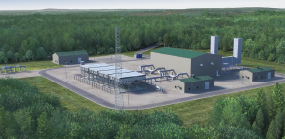Liquefied natural gas (LNG) is becoming a sigdicant factor in providing gas service during peak times in a number of regions of the U.S. and Canada. Based on a survey of LNG facilities conducted for this study, there are currently 85 LNG plants in North America, 56 with liquefaction capability and 29 satellite facilities containing holding tanks and vaporizers but without liquefaction. LNG facilities are located in 24 states and two provinces and are owned by 47 diierent companies, 43 local distribution companies (LDCs) and 4 pipelines. The combined vaporization or sendout capacity of LNG plants total 9.2 billion cubic feet per day (Bcfd), representing over 10 percent of peak capacity in the U.S.
While a number of LNG facilities built in the sixties and seventies were meant to receive imported natural gas, the vast majority of LNG plant in use today process domestic gas and are used primarily for peakshaving, i.e., for reducing the amount of gas service required from a pipeline during peak periods. The resurgence in the use of LNG plants for peakshaving currently taking place can be attributed to two main factors.
First, the Federal Energy Regulatory Commission (FERC) in its Order No. 636 required pipelines to employ the straight fixed-variable (SFV) rate design where all the pipeline’s fixed costs are allocated to demand charges to be paid monthly regardless of actual utilization. For pipeline customers facing low load factors, the SFV rate design resulted in an increased costs of pipeline capacity held for peak service. In many cases, the right to retain pipeline capacity became one of the largest cost items for LDCs serving temperature-sensitive loads. This study estimates the total costs for an LNG plant with 100 MMcfd peak capacity and 2.0 billion of annual sendout capacity at $9.3 6/Mcf.
Second, LNG is an option that can provide peak period gas service without affecting gas properties, compared to the injection of propane-air mixtures, and at locations that are not restricted by geology, as underground storage would be.
In addition, LDCs are beginning to face increased competition in their retail markets with the advent of retail unbundling and the expected lower electricity prices due to restructuring of the electric industry. LDCs, particularly those in New England, Middle Atlantic and North Central states, have been exploring ways to reduce their costs in order to retain market share.
In many cases wheie cost savings are needed, LNG was the most suitable alternative. For example, for peak service that is more than a few days in a year, LNG facilities can offer better economics than propane-air mixtures and for services less than about a month in duration per year, LNG can be more competitive compared to incremental underground storage or pipeline capacity.
In a similar way, pipeline companies desiring to expand service at locations near the end of their service areas are considering LNG as an alternative to building pipeline capacity. In the case of the Cove Point LNG plant, the economics were favorable for converting an import plant into one for peakshaving using domestic gas.
LNG is also expected to benefit from an increased use of natural gas as a vehicular fbel because of its consistent chemical composition and fiom a faster rate of growth in peak demand compared to total demand. A number of new LNG peaking facilities are under development or evaluation including Rhode Island, North Carolina, Georgia and Tennessee. However, similar to pipelines, environmental concerns and public acceptance can represent hurdles to the construction of new LNG plants.



